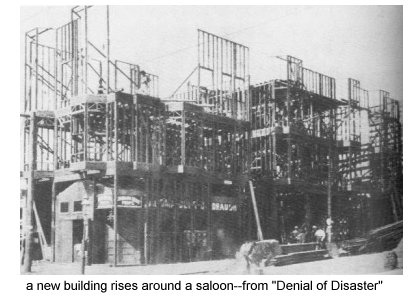

|
| weblog/wEssays archives | home | |
|
The Great San Francisco Earthquake (April 15, 2006)  I was recently tasked to describe how the building code changed after the San
Francisco Earthquake of 1906. The results can be found in today's San Francisco Chronicle:
What San Francisco didn't learn from the '06 quake.
I was recently tasked to describe how the building code changed after the San
Francisco Earthquake of 1906. The results can be found in today's San Francisco Chronicle:
What San Francisco didn't learn from the '06 quake.
While this looks like a snoozer of a topic, you should read the piece if you live in the S.F. Bay Area. San Francisco, it turns out, is still very much at risk of conflagration in a major quake, and one reason is visible in the accompanying photo. Building codes didn't change much until the late 30s, and in the rush to rebuild the city as quickly as possible after the quake/fire, much of the construction repeated the same mistakes which had made the city so vulnerable to fire in 1906: wood frame buildings crammed cheek-by-jowl with no firewalls between them. A firewall is a fire-resistant material designed to slow the spread of fire between rooms or buildings; in modern codes, this is often a double thickness of Type X gypsum board (drywall, sheetrock, etc.). A row of wood houses pushed one against the other is akin to a large wooden warehouse: kindling awaiting a match, with virtually nothing to slow down a fire's advance. Sobering stuff, to be sure, and for a gripping account of the great quake/fire, truly astonishing photos--some of which are eerily reminiscent of Hiroshima after the atomic bombing--and more on fire hazards, check out a copy of Denial of Disaster: The Untold Story and Photographs of the San Francisco Earthquake and Fire or 1906 Another under-appreciated book on the earthquake hazards faced by all of California is A Dangerous Place: California's Unsettling Fate For more on this subject and a wide array of other topics, please visit my weblog. copyright © 2006 Charles Hugh Smith. All rights reserved in all media. I would be honored if you linked this wEssay to your site, or printed a copy for your own use. |
||
| weblog/wEssays | home |